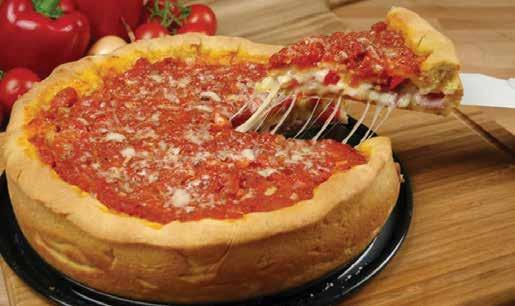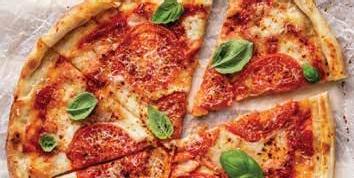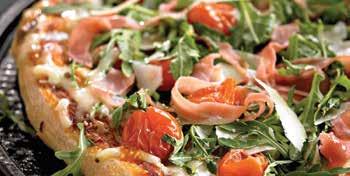
6 minute read
The Perfect Pizza Pie
BY JIM MATHIS
It has been said that pizza is like sex. When it is good, it is really good. And when it’s bad, it’s still pretty good. I can’t argue with that logic. I love a good pizza. And I won’t turn down a mediocre pizza. In all my years of eating pizza, I’ve only found a few that I wouldn’t eat. But I don’t think taco pizza should count.
Why does pizza have such a hold on us? For me I think it goes back to an evening when I was about six. My brother was staying with a friend; my sister was not yet born. So that Friday night was MY night. Mom and Dad said I could choose whatever I wanted for dinner. My choice of course, was pizza, served hot and delicious right out of the cardboard delivery box. On that night, I felt like the King of the World. I had my parents all to myself, and I ate until I made myself sick. Literally, I got sick. But it was my night and my pizza. King of the World, indeed.
Pizza is a nearly perfect food. With bread, meat, vegetables and dairy, it ticks off every box on the old food pyramid. It is great for dinner or lunch, and I challenge you to find a better breakfast when you’ve had a few too many the night before. As a hangover food, it has carbs to soak up what’s left in your belly, some fat to soothe the queasy feelings and little spice to knock some of the crud off your tongue. As I said, a nearly perfect food. History Lesson
Legend tells us that what we know as Pizza Margherita was first created in Naples, Italy, way back in 1889, when Raffaele Esposito was asked to create pizzas in honor of the visiting Queen Margherita. It is said that of all the pies he created, Queen Margherita preferred the one decorated in the colors of the Italian flag: red tomatoes, white mozzarella and bright green basil. Hence forth this noble variety of pizza has been named in her majesty’s honor.
But pizza was around long before that, and many food historians believe that the pizza was not created in Italy, but rather imported from Greece where they made a similar dish on flatbread. The word pizza comes from the Latin verb pìnsere, meaning “to press” and from the Greek pēktos, meaning “solid.” Through the ages, the words and the flatbread both changed as they meandered around Europe and the Middle East finally becoming the Greek pita and Italian pizza we know today.
While the pizza has its roots in the Mediterranean, over the century it has become a truly American food. When the Italian American immigrants in the New York’s Little Italy started their pizzerias in the early years of the 20th century, the pizzas they

created where different than those back home. The available flour and water gave the crust a different taste. The ovens here were fueled by coal or gas instead of wood like back home. As our GIs returned from World War II craving the pizza they had “discovered” in the European theater, the American Pizzeria spread across the country. By the 1960s pizza had become a uniquely American dish. And like anything American, different pizza dialects developed around the country. Pizza Taxonomy The world of pizza can be divided any number of ways, but in my mind, it makes sense to divide it into two distinct groups: Traditional and Deep Dish. The Traditional Pizza is what most of us here on the prairie think of as pizza. Now, it is important to remember that within the phylum of Traditional Pizza there are numerous classes, orders and species. The crust may tossed by hand to create a crispy, almost cracker-thin base or it might be rolled gently to create a thicker and chewy crust. Some will rise as they are baked, coming out of the oven nearly an inch thick while others remain merely millimeters high. In my mind, the perfect pie is very thin, and not over-burdened with toppings.
The Deep Dish grew out of Chicago where places like Uno, Lou Malnati’s, Gino’s East and Pizzeria Due all make fine versions. Deep Dish is great, a hearty pizza you have to eat with a fork. The pan pizza at the local joint is but a poor homage to the original deep dish.
500 E. 69TH ST. LOOKSMARKET.COM PATIO
TIME!
605.336.3104
In my mind this variety of pizza is the primary reason we refer to Chicago as The Second City. For me, a deep dish will always finish second to a good thin crust pie. And I am not alone in thinking this. While the deep dish pizza was born and raised in the City of Big Shoulders, they also have their share of traditional pies.
A class within the phylum of deep dish is the stuffed pizza like you find at Chicago’s Giordano’s. While we often refer to a pizza as a pie, the stuffed pie closely resembles a savory version of your grandma’s apple pie, with a crust on the bottom lining the pan, and another covering the top. This is not just a deep dish, but a mountain of a pie. Each slice of stuffed pizza is a meal. I caution you against trying to tackle one on your own. It’s a big pizza. This is not to be confused with a stuffed crust pizza you may have ordered from a delivery place; those are just a fad within the arena of traditional pizza.
With all of these different kinds of pizza and the wide variety of toppings, you might be led to believe that pizza is like the Wild West, without rules. Oh no my friend, we cannot allow Pizza Anarchy. There must be rules.
The key ingredient in any pizza is restraint. Too much of a good this is just too much. A certain national chain hasn’t grasped this concept. If a few slices of pepperoni are good, they will make a “pepperoni lover’s” that is overwhelmed with sausage. Since people like mozzarella, they will stuff the crust with even more. Worse yet, they have created an abomination encircled by crescent-shaped pools filled with molten mozzarella. Know when to say when.
No Taco Pizza. Ever. So called taco pizza violates what my family refers to as the “Shit and Ice Cream Theory” which states that when two things that do not belong together are mixed, they

Here are my four simple Immutable Laws of Pizza.
will ruin one, and not improve the other. In my mind, mixing tacos and pizza ruins the pizza, and doesn’t help the tacos.


3. Immutable Law of Pizza Number Three:
As long as it doesn’t violate Law Number One, the addition of pork products to pizza is a good thing. Pepperoni, Italian sausage, salami, prosciutto, it’s all good. A simple Margherita becomes a
1. Immutable Law of Pizza Number One:
2. Immutable Law of Pizza Number Two:
thing of beauty when pepperoni joins the party.

4. Immutable Law of Pizza Number Four:
Arugula on a pizza is good. Basil is great. Iceberg lettuce is not.
See law number two.
So what is the perfect pizza pie? It could be the one I eat tomorrow, or the one I ate yesterday. To me the perfect pizza is a moving target, one that changes with my mood and memories of the pizzas that have come and gone. The only thing I know for sure is that it will have a thin crust. Or maybe not.
When he’s not eating pizza, Jim runs ADwërks, and advertising agency in Downtown Sioux Falls.








